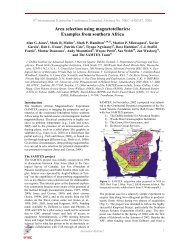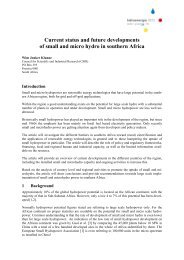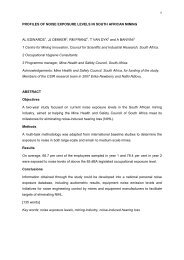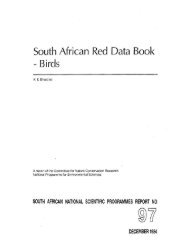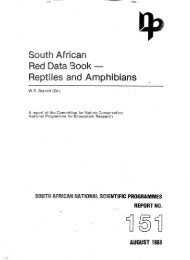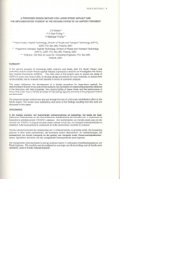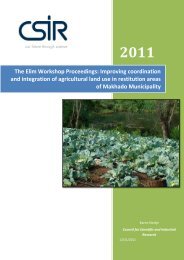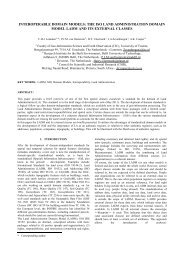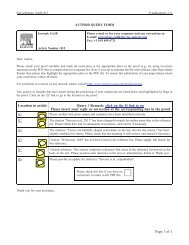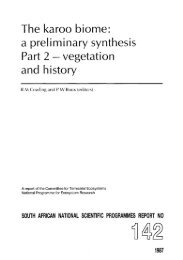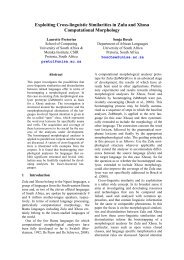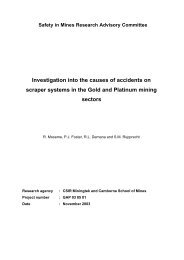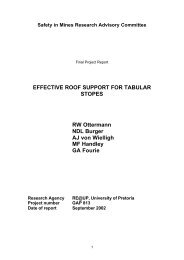Heterologous Expression of Trametes versicolor Laccase in Pichia
Heterologous Expression of Trametes versicolor Laccase in Pichia
Heterologous Expression of Trametes versicolor Laccase in Pichia
Create successful ePaper yourself
Turn your PDF publications into a flip-book with our unique Google optimized e-Paper software.
Copyright © 2006 by Humana Press Inc.<br />
All rights <strong>of</strong> any nature whatsoever reserved.<br />
0273-2289/06/129–132/195–214/$30.00<br />
<strong>Heterologous</strong> <strong>Expression</strong> <strong>of</strong> <strong>Trametes</strong><br />
<strong>versicolor</strong> <strong>Laccase</strong> <strong>in</strong> <strong>Pichia</strong> pastoris<br />
and Aspergillus niger<br />
CHRISTINA BOHLIN, 1 LEIF J. JÖNSSON,* ,1 ROBYN ROTH, 2,3<br />
AND WILLEM H. VAN ZYL 3<br />
1 Biochemistry, Division for Chemistry, Karlstad University, SE-651 88<br />
Karlstad, Sweden, E-mail: Leif.Jonsson@kau.se; 2 Bio/Chemtek, CSIR,<br />
Private Bag X2, Modderfonte<strong>in</strong> 1645, South Africa; and 3 Department<br />
<strong>of</strong> Microbiology, University <strong>of</strong> Stellenbosch, Private Bag X1,<br />
Matieland 7602, South Africa<br />
Abstract<br />
Convenient expression systems for efficient heterologous production <strong>of</strong><br />
different laccases are needed for their characterization and application. The<br />
laccase cDNAs lcc1 and lcc2 from <strong>Trametes</strong> <strong>versicolor</strong> were expressed <strong>in</strong> <strong>Pichia</strong><br />
pastoris and Aspergillus niger under control <strong>of</strong> their respective glyceraldehyde-<br />
3-phosphate dehydrogenase promoters and with the native secretion signal<br />
direct<strong>in</strong>g catalytically active laccase to the medium. P. pastoris batch cultures<br />
<strong>in</strong> shake-flasks gave higher volumetric activity (1.3 U/L) and a better activity<br />
to biomass ratio with glucose than with glycerol or maltose as carbon source.<br />
Prelim<strong>in</strong>ary experiments with fed-batch cultures <strong>of</strong> P. pastoris <strong>in</strong> bioreactors<br />
yielded higher activity (2.8 U/L) than the shake-flask experiments, although<br />
the levels rema<strong>in</strong>ed moderate and useful primarily for screen<strong>in</strong>g purposes.<br />
With A. niger, high levels <strong>of</strong> laccase (2700 U/L) were produced us<strong>in</strong>g a m<strong>in</strong>imal<br />
medium conta<strong>in</strong><strong>in</strong>g sucrose and yeast extract. Recomb<strong>in</strong>ant laccase from<br />
A. niger harbor<strong>in</strong>g the lcc2 cDNA was purified to homogeneity and it was<br />
found to be a 70-kDa homogeneous enzyme with biochemical and catalytic<br />
properties similar to those <strong>of</strong> native T. <strong>versicolor</strong> laccase A.<br />
Index Entries: <strong>Laccase</strong>; heterologous expression; <strong>Pichia</strong> pastoris; Aspergillus<br />
niger.<br />
Introduction<br />
<strong>Laccase</strong>s are phenol-oxidiz<strong>in</strong>g enzymes that are <strong>of</strong> <strong>in</strong>terest <strong>in</strong> several<br />
different applications (reviewed <strong>in</strong> ref. [1]). Possible applications <strong>in</strong>clude<br />
textile process<strong>in</strong>g, detoxification <strong>of</strong> <strong>in</strong>dustrial effluents and pollutants,<br />
detoxification <strong>of</strong> lignocellulose hydrolysates <strong>in</strong> fuel ethanol production,<br />
utilization as an environmentally benign oxidant <strong>in</strong> the production <strong>of</strong><br />
chemicals, delignification <strong>of</strong> pulp for paper manufacture, catalysis <strong>of</strong> graft<strong>in</strong>g<br />
*Author to whom all correspondence and repr<strong>in</strong>t requests should be addressed.<br />
Applied Biochemistry and Biotechnology 195 Vol. 129–132, 2006
196 Bohl<strong>in</strong> et al.<br />
processes <strong>in</strong> the development <strong>of</strong> novel polymers, production <strong>of</strong> fiberboards,<br />
use <strong>in</strong> fuel cells, and utilization <strong>in</strong> biosensors for monitor<strong>in</strong>g phenolic<br />
pollutants and drugs. The properties <strong>of</strong> different laccases show a<br />
great deal <strong>of</strong> divergence. <strong>Laccase</strong>s with high-redox potential, such as the<br />
laccase from the white-rot fungus <strong>Trametes</strong> (Polyporus, Coriolus) <strong>versicolor</strong><br />
(2), are required for oxidation <strong>of</strong> recalcitrant substrates. Consider<strong>in</strong>g the<br />
wide range <strong>of</strong> applications for laccases (1), there is a need for heterologous<br />
expression systems to screen mutated laccases for novel properties or for<br />
large-scale production <strong>of</strong> selected laccases.<br />
Previous studies suggest that yeasts such as <strong>Pichia</strong> pastoris and<br />
Saccharomyces cerevisiae are convenient systems for rapid expression <strong>of</strong> laccase<br />
genes. However, production levels <strong>in</strong> yeast have been quite low (up to<br />
approx 5 mg/L), whereas filamentous fungi <strong>in</strong> general have given 2–30 times<br />
higher levels (10–135 mg/L) (3). P. pastoris is easy to manipulate genetically,<br />
easy to use <strong>in</strong> conventional fed-batch fermentations, secretes low levels <strong>of</strong><br />
native prote<strong>in</strong>s, and capable <strong>of</strong> add<strong>in</strong>g both O- and N-l<strong>in</strong>ked glycans to<br />
secreted prote<strong>in</strong>s (4). Filamentous fungi, such as A. niger, have the ability to<br />
produce and secrete exceptionally large amounts <strong>of</strong> properly folded prote<strong>in</strong>s<br />
with the correct c<strong>of</strong>actors <strong>in</strong>corporated and can produce prote<strong>in</strong>s that conta<strong>in</strong><br />
O- and N-l<strong>in</strong>ked glycans without extensive hyperglycosylation (5–7).<br />
It has been shown previously that production <strong>of</strong> laccase <strong>in</strong> P. pastoris<br />
us<strong>in</strong>g the AOX1 promoter system is negatively affected by <strong>in</strong>creas<strong>in</strong>g<br />
methanol concentration (8). The AOX1 promoter requires methanol for<br />
<strong>in</strong>duction, which makes it difficult to use lower concentrations because that<br />
would negatively affect the mRNA expression level. Therefore, it should be<br />
<strong>of</strong> <strong>in</strong>terest to consider the glyceraldehyde-3-phosphate dehydrogenase promoter<br />
system as an option for expression <strong>in</strong> P. pastoris, as well as <strong>in</strong> A. niger.<br />
In this study, we have explored the potential <strong>in</strong> us<strong>in</strong>g P. pastoris for<br />
screen<strong>in</strong>g purposes and A. niger for production <strong>of</strong> selected laccases. The<br />
cDNAs lcc1 and lcc2 from T. <strong>versicolor</strong> were expressed <strong>in</strong> P. pastoris and<br />
A. niger, and the effects <strong>of</strong> different media and cultivation conditions on<br />
the laccase production levels were <strong>in</strong>vestigated. The recomb<strong>in</strong>ant laccase<br />
expressed <strong>in</strong> A. niger was purified to homogeneity and its biochemical and<br />
catalytic properties were compared to the well-characterized native T. <strong>versicolor</strong><br />
laccases A (LccA) and B (LccB) (2).<br />
Methods<br />
Microbial Stra<strong>in</strong>s and Recomb<strong>in</strong>ant DNA<br />
The lcc1 and lcc2 cDNA genes from T. (Coriolus, Polyporus) <strong>versicolor</strong><br />
(9–11) were used <strong>in</strong> the construction <strong>of</strong> plasmids for expression <strong>of</strong> laccases<br />
<strong>in</strong> P. pastoris and A. niger.<br />
For the expression <strong>in</strong> P. pastoris, the lcc1 and lcc2 cDNA genes were<br />
<strong>in</strong>serted <strong>in</strong>to the vectors pGAPZ A and pGAPZ B, respectively. The expression<br />
cassette <strong>of</strong> the pGAPZ vectors <strong>in</strong>cludes the glyceraldehyde-3-phosphate<br />
Applied Biochemistry and Biotechnology Vol. 129–132, 2006
<strong>Heterologous</strong> <strong>Expression</strong> <strong>of</strong> T. <strong>versicolor</strong> <strong>Laccase</strong> 197<br />
Fig. 1. Construction <strong>of</strong> plasmids for expression <strong>of</strong> laccase <strong>in</strong> A. niger. B, BamH I;<br />
N, Not I; RI, EcoR I; RV, EcoR V; S, Sal I; Sn, SnaB I. pGT1-lcc1-amdSpyrG was made<br />
similarly.<br />
dehydrogenase gene (GAP) promoter region and the transcriptional term<strong>in</strong>ator<br />
<strong>of</strong> the alcohol oxidase 1 gene (AOX1). The pGAPZ vectors are designed<br />
for constitutive expression <strong>in</strong> P. pastoris (Invitrogen, Carlsbad, CA). P. pastoris<br />
SMD1168, a his4 pep4 stra<strong>in</strong>, was transformed by electroporation.<br />
Figure 1 summarizes the construction <strong>of</strong> plasmids for the expression<br />
<strong>in</strong> A. niger D15 (obta<strong>in</strong>ed from TNO, Zeist, The Netherlands). Insertion <strong>of</strong><br />
the lcc1 and lcc2 cDNA genes <strong>in</strong>to the plasmid pGT1, which harbors the<br />
Aspergillus glyceraldehyde-3-phosphate dehydrogenase (gpd) promoter<br />
and glucoamylase (gla) term<strong>in</strong>ator from pSPORT (12), generated pGT1-lcc1<br />
Applied Biochemistry and Biotechnology Vol. 129–132, 2006
198 Bohl<strong>in</strong> et al.<br />
and pGT1-lcc2, respectively. Insertion <strong>of</strong> an amdSpyrG fragment taken from<br />
pBSKII(+)-amdSpyrG generated pGT1-lcc1-amdSpyrG and pGT1-lcc2amdSpyrG,<br />
respectively (Fig. 1). A. niger spheroplasts were formed us<strong>in</strong>g<br />
Novozyme 234 (Sigma, St. Louis, MO) and transformed <strong>in</strong> accordance<br />
with the method <strong>of</strong> Punt and van den Hondel (13).<br />
Selection <strong>of</strong> <strong>Laccase</strong>-Express<strong>in</strong>g Transformants<br />
P. pastoris transformants that survived a concentration <strong>of</strong> 0.1 mg/mL<br />
zeoc<strong>in</strong> were spread on BMG agar plates (Invitrogen) conta<strong>in</strong><strong>in</strong>g glucose<br />
<strong>in</strong>stead <strong>of</strong> glycerol, 0.1 mM CuSO 4 , and 0.2 mM ABTS [2,2′-az<strong>in</strong>o-bis(3ethylbenzothiazol<strong>in</strong>e-6-sulfonic<br />
acid)]. The color development was followed<br />
at room temperature (approx 22°C). <strong>Laccase</strong>-express<strong>in</strong>g transformants were<br />
selected and <strong>in</strong>cubated <strong>in</strong> 50 mL buffered m<strong>in</strong>imal glycerol (BMG) medium<br />
with 0.1 mM CuSO 4 . An addition <strong>of</strong> 0.3 mL <strong>of</strong> a 0.6 M solution <strong>of</strong> potassium<br />
phosphate (pH 6.0) and 0.2 mL <strong>of</strong> a 0.4 M solution <strong>of</strong> NaOH was made daily.<br />
For selection <strong>of</strong> top laccase producers, samples were taken daily to determ<strong>in</strong>e<br />
the laccase activity (see Analyses <strong>of</strong> Samples).<br />
A. niger transformants conta<strong>in</strong><strong>in</strong>g the lcc1 and lcc2 cDNA constructs as<br />
well as a negative control stra<strong>in</strong> obta<strong>in</strong>ed from a transformation <strong>of</strong> A. niger<br />
D15 with the pBSKII(+)-amdSpyrG plasmid (Fig. 1) were plated onto agar<br />
plates conta<strong>in</strong><strong>in</strong>g 5% glucose, 0.2% am<strong>in</strong>o acid pool without tyros<strong>in</strong>e or<br />
phenylalan<strong>in</strong>e (200 mg each <strong>of</strong> aden<strong>in</strong>e, uracil, tryptophan, arg<strong>in</strong><strong>in</strong>e, methion<strong>in</strong>e,<br />
and histid<strong>in</strong>e; 300 mg <strong>of</strong> lys<strong>in</strong>e; 600 mg <strong>of</strong> leuc<strong>in</strong>e; 2000 mg <strong>of</strong> threon<strong>in</strong>e;<br />
and 65 mg <strong>of</strong> <strong>in</strong>ositol), 0.5% yeast extract, 0.1 mM CuSO 4 , 2 mM MgSO 4 , 0.1%<br />
ABTS, 0.1% 1000× trace elements [the 1000X trace element solution conta<strong>in</strong>ed<br />
(per 100 mL deionized water) 2.2 g ZnSO 4 ⋅7H 2 O, 1.1 g H 3 BO 3 , 0.5 g<br />
MnCl 2 ⋅4H 2 O, 0.17 g CoCl 2 ⋅6H 2 O, 0.16 g CuSO 4 ⋅5H 2 O, 0.15 g Na 2 MoO 4 ⋅2<br />
H 2 O, 5 g ethylene diam<strong>in</strong>e tetraacetic acid (EDTA), and the pH was 6.5], and<br />
1× AspA with nitrate [50X AspA with nitrate conta<strong>in</strong>ed (per 500 mL deionized<br />
water): 150 g NaNO 3 , 13 g KCl, 38 g KH 2 PO 4 ]. The plates were <strong>in</strong>cubated at<br />
30°C for 48 h and the color development was followed. <strong>Laccase</strong>-express<strong>in</strong>g<br />
A. niger transformants were transferred to 50 mL medium conta<strong>in</strong><strong>in</strong>g 0.5%<br />
yeast extract, 1% glucose, 0.1% casam<strong>in</strong>o acids (Difco, BD, Frankl<strong>in</strong> Lakes,<br />
NJ), 2% MgSO 4 ⋅7H 2 O, 1X trace element solution, and 1X AspA with nitrate by<br />
<strong>in</strong>oculation with spores to a concentration <strong>of</strong> 1 × 10 6 spores/mL (experimental<br />
series 1). The cultures were then grown for 48, 72, or 144 h. The mycelia were<br />
harvested by filter<strong>in</strong>g through Miracloth (Calbiochem, San Diego, CA) and<br />
the culture supernatants were collected to determ<strong>in</strong>e the laccase activity.<br />
Shake-Flask Cultivations <strong>of</strong> P. pastoris<br />
A selected laccase-produc<strong>in</strong>g transformant (designated P. pastoris/<br />
lcc2) was <strong>in</strong>cubated <strong>in</strong> BMG medium and also <strong>in</strong> the same medium but with<br />
glucose or maltose <strong>in</strong>stead <strong>of</strong> glycerol. The <strong>in</strong>itial concentration <strong>of</strong> carbon<br />
source was 0.5–3%. The concentration <strong>of</strong> YNB (Yeast Nitrogen Base w/o<br />
am<strong>in</strong>o acids, a component <strong>of</strong> BMG medium), was varied <strong>in</strong> the range<br />
1–3%. In addition, the medium conta<strong>in</strong>ed 0.4% histid<strong>in</strong>e, 1 mM CuSO 4 , and<br />
Applied Biochemistry and Biotechnology Vol. 129–132, 2006
<strong>Heterologous</strong> <strong>Expression</strong> <strong>of</strong> T. <strong>versicolor</strong> <strong>Laccase</strong> 199<br />
0.8% alan<strong>in</strong>e. The cultivation was allowed to cont<strong>in</strong>ue for 7 d at 20°C and<br />
samples were taken daily to determ<strong>in</strong>e the laccase activity.<br />
Parallel Fed-Batch Cultivations <strong>of</strong> P. pastoris <strong>in</strong> Multibioreactor<br />
Preparation <strong>of</strong> Inoculum<br />
A colony <strong>of</strong> P. pastoris/lcc2 conta<strong>in</strong><strong>in</strong>g pGAPZ/lcc2 was transferred<br />
from a yeast peptone dextrose (YPD) agar plate <strong>in</strong>to a baffled flask conta<strong>in</strong><strong>in</strong>g<br />
200 mL <strong>of</strong> yeast peptone dextrose (YPD) (10 g/L yeast extract, 20 g/L peptone,<br />
and 20 g/L glucose) and <strong>in</strong>cubated at 30°C with shak<strong>in</strong>g (200 rpm <strong>in</strong><br />
a G25 orbital shaker, New Brunswick Scientific, Edison, NJ) for 20 h until<br />
an OD 600 (optical density at 600 nm) <strong>of</strong> greater than 3 was reached.<br />
Batch Phase<br />
A Sixfors multibioreactor system (Infors, Bottm<strong>in</strong>gen-Basel, Switzerland)<br />
equipped with three parallel temperature-controlled 500 mL bioreactors with<br />
sensors for pH and pO 2 was used. Each bioreactor conta<strong>in</strong>ed 180-mL basal salt<br />
medium (Invitrogen) not <strong>in</strong>clud<strong>in</strong>g glycerol but supplemented with 4% glucose,<br />
2 g/L histid<strong>in</strong>e, 4.35 mL/L PTM trace salt solution (Invitrogen), and<br />
0.2 mM CuSO 4 . The pH <strong>of</strong> the medium was adjusted to 5.0 with 28% ammonium<br />
hydroxide before the <strong>in</strong>oculum (3 mL) was added to a f<strong>in</strong>al OD 600 <strong>of</strong> 1.<br />
The bioreactors were ma<strong>in</strong>ta<strong>in</strong>ed at a temperature <strong>of</strong> 20°C and at an agitation<br />
rate <strong>of</strong> 1000 rpm. Air was <strong>in</strong>troduced <strong>in</strong>to the bioreactor at a rate <strong>of</strong> 30 L/h and<br />
the pH was automatically ma<strong>in</strong>ta<strong>in</strong>ed at 5.0 by the addition <strong>of</strong> a 2.8% ammonium<br />
hydroxide solution. The batch phase was allowed to cont<strong>in</strong>ue until the<br />
glucose was depleted, which occurred after approx 40 h. Thereafter, the fedbatch<br />
phase was <strong>in</strong>itiated.<br />
Fed-Batch Phase<br />
The medium that was fed <strong>in</strong>to the bioreactor was the same as <strong>in</strong> the<br />
batch phase, except that different concentrations <strong>of</strong> glucose were used.<br />
Bioreactors A–C were fed with glucose at a rate <strong>of</strong> 0.06, 0.17, and 0.43<br />
g/h, respectively. Samples were taken daily and centrifuged <strong>in</strong> a M<strong>in</strong>i<br />
Sp<strong>in</strong> microcentrifuge (Eppendorf, Hamburg, Germany) at maximum<br />
speed for 15 m<strong>in</strong>. The supernatants were transferred to fresh tubes,<br />
which were snap-frozen <strong>in</strong> liquid nitrogen. Samples were analyzed with<br />
respect to laccase activity, prote<strong>in</strong> concentration, protease activity,<br />
OD 600 , wet cell weight (WCW), and glucose concentration (see Analyses<br />
<strong>of</strong> Samples).<br />
Media Optimization for A. niger Transformants<br />
Us<strong>in</strong>g Shake-Flask Cultures<br />
Experimental Series 2 and 3<br />
To determ<strong>in</strong>e optimal medium composition for laccase production,<br />
spores <strong>of</strong> the A. niger transformant express<strong>in</strong>g the highest level <strong>of</strong> laccase<br />
(designated A. niger/lcc2) were used to <strong>in</strong>oculate different media (Table 1)<br />
Applied Biochemistry and Biotechnology Vol. 129–132, 2006
200 Bohl<strong>in</strong> et al.<br />
Table 1<br />
Media Used for Optimization <strong>of</strong> <strong>Laccase</strong> Production by A. niger<br />
to a f<strong>in</strong>al concentration <strong>of</strong> 1 × 10 6 spores/mL. The <strong>in</strong>oculum was generated<br />
by resuspend<strong>in</strong>g spores <strong>in</strong> a sterile 0.9% NaCl solution. The spore suspension<br />
was stored at 4°C until use. The cultures were <strong>in</strong>cubated <strong>in</strong> a volume<br />
<strong>of</strong> 100 mL at 30°C with shak<strong>in</strong>g (200 rpm). The performance <strong>of</strong> the transformant<br />
<strong>in</strong> media A–D (experimental series 2) (Table 1) was studied for 4 d.<br />
In the experiments with media E–G (experimental series 3) (Table 1), the<br />
cultivation was allowed to cont<strong>in</strong>ue for 10 d.<br />
Experimental Series 4<br />
The media optimization was cont<strong>in</strong>ued by <strong>in</strong>vestigat<strong>in</strong>g the effect <strong>of</strong> the<br />
addition <strong>of</strong> 0.5% yeast extract to the medium, as well as the use <strong>of</strong> a preculture.<br />
The 20-mL precultures were all <strong>in</strong>oculated to a f<strong>in</strong>al concentration <strong>of</strong><br />
5 × 10 6 spores/mL us<strong>in</strong>g the A. niger/lcc2 transformant. The precultures were<br />
<strong>in</strong>cubated at 30°C for 36 h and then transferred to 80-mL fresh media.<br />
Experimental Series 5<br />
Additional experiments were carried out at pH 4.0–6.0 and at 25°C<br />
and 30°C. The laccase activity was measured daily. The results <strong>of</strong> these and<br />
earlier experiments were used to plan the follow<strong>in</strong>g experiment.<br />
Experimental Series 6<br />
Media composition<br />
Ingredient (g/L) A B C D E F G<br />
(NH 4 ) 2 SO 4 45 3 a<br />
KH 2 PO 4 23 1.5 b 1.5 b 1.5 b<br />
FeSO 4 ⋅H 2 O 0.1<br />
MgSO 4 ⋅7H 2 O 7 0.49 c 0.49 c 0.49 c 0.49 c 0.49 c 0.98 d<br />
Sucrose 50 50 100<br />
Urea 11<br />
Yeast extract 5 5 5 5<br />
Glucose 10 100 10<br />
1000X trace elements 1 mL 1 mL 1 mL 1 mL 1 mL 2 mL<br />
NaNO 3 6 b 6 b 5.95 6 b 6 b 12 a<br />
KCl 0.52 b 0.52 b 0.52 0.52 b 0.52 b 1.04 a<br />
NaH2PO4 35.60<br />
Initial pH 4, 5, 6 4, 5, 6 4, 5, 6 5 5 5 5<br />
a As 40 mL 50X AspA+N salts.<br />
b As 20 mL 50X AspA+N salts.<br />
c As 2 mL <strong>of</strong> 1 M.<br />
d As 4 mL <strong>of</strong> 1 M.<br />
The production <strong>of</strong> laccase by the transformant A. niger/lcc2 was followed<br />
over a time period <strong>of</strong> 10 d <strong>in</strong> cultures with three different media <strong>in</strong><br />
a volume <strong>of</strong> 250 mL. The first medium consisted <strong>of</strong> a m<strong>in</strong>imal salt medium<br />
Applied Biochemistry and Biotechnology Vol. 129–132, 2006
<strong>Heterologous</strong> <strong>Expression</strong> <strong>of</strong> T. <strong>versicolor</strong> <strong>Laccase</strong> 201<br />
(0.05% MgSO 4 ⋅7H 2 O, 0.6% NaNO 3 , 0.05% KCl, 0.15% KH 2 PO 4, 1X trace<br />
elements) supplemented with 1% glucose and 0.5% yeast extract. The second<br />
medium was a double-strength m<strong>in</strong>imal salt medium (0.1%<br />
MgSO 4 ⋅7H 2 O, 1.2% NaNO 3 , 0.1% KCl, 0.3% KH 2 PO 4 , 2X trace elements)<br />
with 10% sucrose. The third medium was the same as the second but supplemented<br />
with 0.5% yeast extract. The pH <strong>of</strong> the first two media at the<br />
time <strong>of</strong> <strong>in</strong>oculation was 5.0, whereas the pH <strong>of</strong> the third was 6.0.<br />
Purification <strong>of</strong> <strong>Heterologous</strong>ly Expressed <strong>Laccase</strong> From A. niger<br />
The transformant A. niger/lcc2 was cultivated <strong>in</strong> 250 mL <strong>of</strong> previously<br />
optimized medium (0.1% MgSO 4 ⋅7 H 2 O, 1.2% NaNO 3 , 0.1% KCl,<br />
0.3% KH 2 PO 4 , 2X trace elements) with 10% sucrose and 0.5% yeast<br />
extract, and with the pH adjusted to 6.0. The culture was <strong>in</strong>oculated to<br />
1 × 10 6 spores/mL and <strong>in</strong>cubated at 30°C and 200 rpm for 11 d. The<br />
extracellular fraction was harvested by filtration. Ammonium sulfate<br />
precipitation was carried out at 70% saturation (at pH 4.2). The harvested<br />
prote<strong>in</strong> precipitate was resuspended <strong>in</strong> 20 mM imidazole buffer, pH 7.0,<br />
and then snap-frozen <strong>in</strong> liquid N 2 <strong>in</strong> aliquots. The aliquots were freezedried<br />
and stored at –70°C. They were then resuspended <strong>in</strong> a 20 mM solution<br />
<strong>of</strong> potassium phosphate (pH 6.0) and dialyzed aga<strong>in</strong>st the same<br />
buffer before purification.<br />
The first purification step was done by load<strong>in</strong>g the dialyzed sample<br />
onto a DEAE Sepharose Fast Flow column (Amersham Biosciences,<br />
Uppsala, Sweden), pre-equilibrated with 100 mM phosphate buffer (pH 6.0).<br />
A NaCl gradient from 0 to 500 mM was applied to the column, and the laccase<br />
started elut<strong>in</strong>g at 40 mM NaCl. Fractions collected between 40 and 125<br />
mM NaCl were pooled and dialyzed aga<strong>in</strong>st 20 mM 3-(N-morphol<strong>in</strong>o<br />
propanesulfonic acid) MOPS buffer, pH 7.2, overnight.<br />
The second purification step was done by load<strong>in</strong>g the dialyzed DEAE<br />
fractions onto a HiTrap Q FF column (Amersham Biosciences) equilibrated<br />
with 20 mM MOPS, pH 7.2. The prote<strong>in</strong> was eluted with a 0–500 mM NaCl<br />
gradient. The laccase eluted from 150 mM NaCl. Fractions collected<br />
between 150 and 250 mM NaCl were pooled and dialyzed overnight<br />
aga<strong>in</strong>st 10 mM MOPS, pH 6.5.<br />
The dialyzed prote<strong>in</strong> solution was concentrated 15 times, us<strong>in</strong>g 5-kDa<br />
cut<strong>of</strong>f sp<strong>in</strong> columns (Millipore, Bedford, MA). This preparation was used for<br />
k<strong>in</strong>etic analysis and comparison with two different forms <strong>of</strong> the native prote<strong>in</strong>,<br />
laccase A (LccA) and laccase B (LccB), isolated from T. <strong>versicolor</strong> (2,14).<br />
A further purification step was carried out by load<strong>in</strong>g the HiTrap Qpurified<br />
prote<strong>in</strong> onto a MonoP HR 5/20 column (Amersham Biosciences).<br />
The column was equilibrated with 20 mM MOPS buffer, pH 7.2, and a pH<br />
gradient from 7.2 to 3.0 was applied us<strong>in</strong>g 10% PolyBuffer 74 (Amersham<br />
Biosciences), pH 3.0, as eluent. A peak was visible for fractions elut<strong>in</strong>g at pH<br />
3.0–4.0 and the relevant fractions were neutralized by add<strong>in</strong>g 100 µL <strong>of</strong> 1 M<br />
Tris-HCl per 2 mL fraction and pooled. The prote<strong>in</strong> solution was dialyzed<br />
Applied Biochemistry and Biotechnology Vol. 129–132, 2006
202 Bohl<strong>in</strong> et al.<br />
aga<strong>in</strong>st 10 mM phosphate buffer, pH 6.0, and concentrated us<strong>in</strong>g the 5-kDa<br />
sp<strong>in</strong> columns.<br />
Analyses <strong>of</strong> Samples<br />
<strong>Laccase</strong> Activity<br />
Assays were performed as described previously (9). One unit was<br />
def<strong>in</strong>ed as the amount <strong>of</strong> laccase that forms 1 µmol <strong>of</strong> ABTS radical cation<br />
(ε = 3.6 × 10 4 /M/cm at 414 nm [15]). To avoid assay <strong>in</strong>terference by<br />
medium components, the laccase activity <strong>in</strong> samples from P. pastoris cultures<br />
was measured after purification <strong>of</strong> the samples us<strong>in</strong>g Microsp<strong>in</strong> G-25<br />
columns (Amersham Biosciences, Sweden) equilibrated with 10 mM phosphate<br />
buffer (pH 6.0).<br />
Prote<strong>in</strong> Concentration<br />
The prote<strong>in</strong> concentrations <strong>in</strong> samples from P. pastoris cultures were<br />
determ<strong>in</strong>ed us<strong>in</strong>g Coomassie prote<strong>in</strong> assay reagent (Pierce, Rockford, IL)<br />
with bov<strong>in</strong>e-serum album<strong>in</strong> as the standard. The prote<strong>in</strong> concentrations <strong>in</strong><br />
samples from A. niger cultures were estimated us<strong>in</strong>g the Lowry method<br />
(16). Dur<strong>in</strong>g the purification <strong>of</strong> laccase from A. niger, the prote<strong>in</strong> concentration<br />
was determ<strong>in</strong>ed us<strong>in</strong>g the BCA prote<strong>in</strong> assay reagent kit (Pierce, IL).<br />
Optical Density<br />
The OD <strong>of</strong> the samples was measured aga<strong>in</strong>st distilled water at 600 nm<br />
with a ultraviolet-1601PC spectrophotometer (Shimadzu, Kyoto, Japan)<br />
after appropriate dilution.<br />
Wet Cell Weight<br />
The WCW was determ<strong>in</strong>ed by centrifugation <strong>of</strong> the samples at maximum<br />
speed with a M<strong>in</strong>i Sp<strong>in</strong> centrifuge (Eppendorf, Germany) for 15<br />
m<strong>in</strong> <strong>in</strong> preweighed test tubes and subsequent removal <strong>of</strong> the supernatant.<br />
Glucose Concentration<br />
The glucose concentration was determ<strong>in</strong>ed us<strong>in</strong>g a Glucometer Elite<br />
XL (Bayer, Leverkusen, Germany) after appropriate dilution <strong>in</strong> artificial<br />
liquor conta<strong>in</strong><strong>in</strong>g (per liter <strong>of</strong> deionized water) 8.65 mg NaCl, 176.4 mg<br />
CaCl 2 ⋅2H 2 O, 182.9 mg MgCl 2 ⋅6H 2 O, 201.3 mg KCl, and NaOH to a pH <strong>of</strong> 7.4.<br />
Electrophoresis<br />
Estimation <strong>of</strong> the purity, size, and pI <strong>of</strong> the enzyme was obta<strong>in</strong>ed by<br />
us<strong>in</strong>g the PhastGel system (Amersham Biosciences), with a 4–15% gradient<br />
gel for sodium dodecyl sulfate-polyacrylamide gel electrophoresis<br />
(SDS-PAGE) and an isoelectric focus<strong>in</strong>g (IEF) 3–9 gel for IEF. Two identical<br />
IEF gels were run at the same time and one was sta<strong>in</strong>ed with Coomassie<br />
brilliant blue. The other was used for zymogram analysis and was<br />
immersed for 5 m<strong>in</strong> <strong>in</strong> a solution <strong>of</strong> 0.4 mM ABTS <strong>in</strong> 50 mM NaAc, pH 5.0.<br />
Applied Biochemistry and Biotechnology Vol. 129–132, 2006
<strong>Heterologous</strong> <strong>Expression</strong> <strong>of</strong> T. <strong>versicolor</strong> <strong>Laccase</strong> 203<br />
Glycosylation<br />
To determ<strong>in</strong>e the level <strong>of</strong> glycosylation <strong>of</strong> the recomb<strong>in</strong>ant laccase<br />
and the native LccA sample, deglycosylation was carried out us<strong>in</strong>g N-glycosidase<br />
F (Roche, Mannheim, Germany). First, 8 µg <strong>of</strong> laccase (<strong>in</strong> 5 µL <strong>of</strong><br />
a solution <strong>of</strong> 1% SDS, 1% β-mercaptoethanol, and 20 mM sodium phosphate<br />
[pH 8.6]) was denatured by boil<strong>in</strong>g for 3 m<strong>in</strong>. The denatured sample<br />
was subsequently deglycosylated <strong>in</strong> a f<strong>in</strong>al volume <strong>of</strong> 20 µL conta<strong>in</strong><strong>in</strong>g 1%<br />
Nonidet P-40, 0.5% EDTA, 1% β-mercaptoethanol, 25 mM sodium phosphate<br />
buffer (pH 7.2), 0.25% SDS, and 5 U <strong>of</strong> the deglycosylation enzyme.<br />
The reactions were <strong>in</strong>cubated at 37°C for 2 h, and 4 µL was loaded onto a<br />
12% homogeneous SDS-PAGE gel us<strong>in</strong>g the PhastGel system. Control<br />
reactions without N-glycosidase F addition were done <strong>in</strong> parallel.<br />
K<strong>in</strong>etic Analysis<br />
The K M values <strong>of</strong> LccA, LccB, and the recomb<strong>in</strong>ant laccase purified<br />
from A. niger were determ<strong>in</strong>ed us<strong>in</strong>g the substrate 2,4,5-trimethoxylbenzyl<br />
alcohol and were performed as described elsewhere (32).<br />
Protease Activity<br />
The protease activity was determ<strong>in</strong>ed us<strong>in</strong>g the QuantiCleave fluorescent<br />
protease assay kit (Pierce, IL), which is based on proteolytic digestion<br />
<strong>of</strong> a fluoresce<strong>in</strong> thiocarbamoyl-case<strong>in</strong> conjugate and measurement <strong>of</strong><br />
the fluorescence at 538 nm. The proteolytic activity at pH 5.0 was assayed<br />
us<strong>in</strong>g an LS 55 lum<strong>in</strong>escence spectrometer (Perk<strong>in</strong>Elmer, Wellesley, MA).<br />
Results and Discussion<br />
The expression <strong>of</strong> two isoenzymes <strong>of</strong> laccase from T. <strong>versicolor</strong> <strong>in</strong><br />
P. pastoris and A. niger was <strong>in</strong>vestigated. In both cases, the expression was<br />
under the control <strong>of</strong> the glyceraldehyde-3-phosphate dehydrogenase promoter,<br />
the GAP promoter <strong>of</strong> P. pastoris (17) and the gpd promoter <strong>of</strong><br />
Aspergillus (18). The GAP promoter gives constitutive expression, although<br />
its strength varies depend<strong>in</strong>g on the carbon source (17). This is the first<br />
report <strong>of</strong> a laccase expressed <strong>in</strong> P. pastoris with the GAP promoter, as previous<br />
attempts have been made us<strong>in</strong>g the AOX1 promoter.<br />
Analysis <strong>of</strong> shake-flask cultures revealed that P. pastoris transformants<br />
with the lcc2 gene gave approx three to four times higher activity<br />
than transformants with the lcc1 gene (Fig. 2A). The transformant giv<strong>in</strong>g<br />
the highest activity (P. pastoris/lcc2) (approx 0.6 U/L) (Fig. 2A) was chosen<br />
for further studies. The choice <strong>of</strong> laccase gene for expression appears to<br />
have a great impact on the levels <strong>of</strong> activity reached.<br />
Shake-flask cultures <strong>of</strong> P. pastoris/lcc2, <strong>in</strong> which the type and concentration<br />
<strong>of</strong> carbon source were varied, gave higher laccase activity (1.3 U/L)<br />
with glucose than with glycerol (0.7 U/L) or maltose (0.6 U/L) (Fig. 2B).<br />
Cells grown on glycerol showed higher growth rate than cells grown on<br />
glucose, which <strong>in</strong> turn showed higher growth rate than cells grown on<br />
Applied Biochemistry and Biotechnology Vol. 129–132, 2006
204 Bohl<strong>in</strong> et al.<br />
Fig. 2. Shake-flask cultures <strong>of</strong> P. pastoris. (A) Comparison <strong>of</strong> lcc1 and lcc2 transformants,<br />
(B 1 ) volumetric activity with P. pastoris/lcc2, (B 2 ) ratio <strong>of</strong> activity to biomass<br />
with P. pastoris/lcc2.<br />
maltose. The cultures reached an OD 600 <strong>of</strong> 27 (glycerol), 20 (glucose), and<br />
10 (maltose). Previous results suggest that a slow growth rate is usually<br />
better for reach<strong>in</strong>g high-laccase activity (8), but the maltose cultures did<br />
not follow that trend. The ratio <strong>of</strong> activity to biomass was higher with glucose<br />
than with maltose or glycerol (Fig. 2B). This result shows that the laccase<br />
activity depends on more than just the growth rate. Growth on<br />
different carbon sources results <strong>in</strong> dist<strong>in</strong>ct patterns <strong>of</strong> <strong>in</strong>tracellular prote<strong>in</strong>s<br />
(19), which <strong>in</strong> turn may affect the production <strong>of</strong> heterologous prote<strong>in</strong>s. For<br />
laccase production, a glucose concentration <strong>of</strong> 1% was better than 2–3%<br />
(Fig. 2B). When even lower glucose concentrations were studied, 0.5% glucose<br />
gave about the same activity to biomass ratio as 1% glucose (not<br />
shown). The activities reached with the GAP promoter can be compared<br />
Applied Biochemistry and Biotechnology Vol. 129–132, 2006
<strong>Heterologous</strong> <strong>Expression</strong> <strong>of</strong> T. <strong>versicolor</strong> <strong>Laccase</strong> 205<br />
Fig. 3. Bioreactor cultures <strong>of</strong> P. pastoris/lcc2. (A) Glucose concentration and<br />
biomass, (B) units (µmol/m<strong>in</strong>) and units/biomass. Filled symbols show biomass and<br />
units/biomass [fermentor A (•), fermentor B (▲), and fermentor C (■)]. Open symbols<br />
show glucose concentration and units.<br />
with the expression <strong>of</strong> the same gene but with the AOX1 promoter, which<br />
gave an activity <strong>of</strong> 0.35 U/L <strong>in</strong> the X-33 stra<strong>in</strong>.<br />
The <strong>in</strong>fluence <strong>of</strong> different feed<strong>in</strong>g rates <strong>of</strong> glucose on the selected<br />
P. pastoris/lcc2 transformant was <strong>in</strong>vestigated <strong>in</strong> parallel fed-batch cultures<br />
us<strong>in</strong>g a multibioreactor system (Fig. 3). The batch phase lasted for about<br />
40 h (Fig. 3A) and resulted <strong>in</strong> a biomass concentration <strong>of</strong> 40–60 g/L. In the<br />
fed-batch phase, glucose was added at different rates for 82 h and the<br />
biomass concentrations <strong>in</strong> the bioreactors started to vary (Fig. 3A). The<br />
biomass concentration <strong>in</strong> fermentor A did not <strong>in</strong>crease that much <strong>in</strong> the<br />
fed-batch phase, whereas fermentors B and C reached biomass concentrations<br />
<strong>of</strong> 80–90 g/L and 130–140 g/L, respectively. Fermentor C reached the<br />
highest volumetric activity (2.8 U/L), whereas fermentors B and A reached<br />
1.8 and 1.3 U/L, respectively. The activity <strong>in</strong>creased until approx 90 h, and<br />
Applied Biochemistry and Biotechnology Vol. 129–132, 2006
206 Bohl<strong>in</strong> et al.<br />
thereafter the level was constant or decreased slightly (Fig. 3B). The ratio<br />
<strong>of</strong> activity to biomass was slightly higher <strong>in</strong> fermentor A (Fig. 3B), but the<br />
relatively low values compared to the shake-flask cultures (Fig. 2B) <strong>in</strong>dicate<br />
that further improvements should be possible. The specific activity<br />
(not shown) <strong>in</strong>creased for about 50 h and subsequently leveled <strong>of</strong>f.<br />
Compared to a number <strong>of</strong> reports document<strong>in</strong>g high-level expression<br />
<strong>of</strong> foreign genes <strong>in</strong> P. pastoris (4,20), the concentration <strong>of</strong> secreted prote<strong>in</strong> <strong>in</strong><br />
this study (0.1 g/L) was satisfactory. When laccases from Pleurotus sajorcaju<br />
(21) and Pycnoporus c<strong>in</strong>nabar<strong>in</strong>us (22) were expressed <strong>in</strong> P. pastoris<br />
us<strong>in</strong>g the AOX1 system, the prote<strong>in</strong> concentrations were 0.11 and 0.008<br />
g/L, respectively. Although the total prote<strong>in</strong> concentration <strong>in</strong> our study<br />
was at the same level or higher, the specific activity was much lower than<br />
<strong>in</strong> those studies (21,22). The use <strong>of</strong> controlled conditions <strong>in</strong> a bioreactor<br />
<strong>in</strong>stead <strong>of</strong> us<strong>in</strong>g shake-flasks generally improves heterologous prote<strong>in</strong><br />
production (20). The laccase production reported <strong>in</strong> the current study<br />
could probably be enhanced further by optimization <strong>of</strong> medium and cultivation<br />
conditions.<br />
When P. pastoris was used to express and determ<strong>in</strong>e the size <strong>of</strong> laccases<br />
from T. <strong>versicolor</strong> (8), P. c<strong>in</strong>nabar<strong>in</strong>us (22), Fome lignosus (23), and P. sajor-caju<br />
(21), the recomb<strong>in</strong>ant laccases were found to be between 5% and 36%<br />
larger then the native enzymes, strongly <strong>in</strong>dicat<strong>in</strong>g hyperglycosylation.<br />
However, no reports show that hyperglycosylation affects the activity <strong>of</strong><br />
the enzyme produced.<br />
The use <strong>of</strong> a prote<strong>in</strong>ase A mutant (pep4) stra<strong>in</strong> (SMD1168) has been<br />
reported to be beneficial for the production <strong>of</strong> secreted recomb<strong>in</strong>ant prote<strong>in</strong>s<br />
(24), and that has also been observed for laccase (9). In this study, the<br />
protease level <strong>in</strong> the fermentation medium was around 0.6 µg/mL (with<br />
N-tosyl-L-phenylalan<strong>in</strong>e chloromethyl ketone (TPCK) tryps<strong>in</strong> as the standard)<br />
after 17 h and was fairly constant throughout the whole fermentation,<br />
never reach<strong>in</strong>g a level greater than 1 µg/mL. It has been shown that<br />
cells grown on glycerol have lower levels <strong>of</strong> total protease activity compared<br />
with cells grown on methanol as the sole carbon source (25). This<br />
could be a problem when laccase is expressed with the AOX1 promoter and<br />
is one <strong>of</strong> the reasons why alternative carbon sources are <strong>of</strong> <strong>in</strong>terest to study.<br />
Very few transformants were obta<strong>in</strong>ed for A. niger. The transformation<br />
with pGT1-lcc1-amdSpyrG and pGT1-lcc2-amdSpyrG gave rise to n<strong>in</strong>e<br />
and seven transformants, respectively. Of these 16 transformants, 11<br />
showed color development on ABTS plates. No development <strong>of</strong> color was<br />
observed with the control transformed with pBSKII(+)-amdSpyrG.<br />
To select a top laccase producer, transformants were grown <strong>in</strong> shakeflasks<br />
(experimental series 1). The results obta<strong>in</strong>ed showed that most <strong>of</strong> the<br />
activity was lost by 144 h, with the relative activities at 48 and 72 h be<strong>in</strong>g<br />
very similar (data not shown). Aga<strong>in</strong>, the control transformant showed no<br />
activity. Specific activities <strong>of</strong> laccase <strong>in</strong> the supernatants were calculated<br />
<strong>in</strong>dicat<strong>in</strong>g that lcc2 gave higher specific activity than lcc1, although the<br />
Applied Biochemistry and Biotechnology Vol. 129–132, 2006
<strong>Heterologous</strong> <strong>Expression</strong> <strong>of</strong> T. <strong>versicolor</strong> <strong>Laccase</strong> 207<br />
Fig. 4. Media optimization for A. niger/lcc2 <strong>in</strong> (A) experimental series 2 with media<br />
A–D, (B) experimental series 3 with media E–G, and (C) experimental series 4 with<br />
and without preculture.<br />
activity also varied between lcc2 transformants (data not shown). The<br />
average volumetric and specific activity was almost 10 times higher for<br />
the lcc2 transformants <strong>in</strong> comparison to the lcc1 transformants. An lcc2<br />
transformant (A. niger/lcc2) was selected to be used <strong>in</strong> shake-flask analysis<br />
for media optimization.<br />
<strong>Laccase</strong> production <strong>in</strong> media A–D was studied dur<strong>in</strong>g 4 d <strong>of</strong> cultivation<br />
(Fig. 4A). Medium A (high salts) was used by Balasubramaniem et al.<br />
(26) for the production <strong>of</strong> β-fruct<strong>of</strong>uranosidase <strong>in</strong> A. niger NRRL 330.<br />
Applied Biochemistry and Biotechnology Vol. 129–132, 2006
208 Bohl<strong>in</strong> et al.<br />
Growth <strong>in</strong> medium A gave no extracellular laccase activity, and very low<br />
biomass concentration (4–5 g/L after 4 d) was obta<strong>in</strong>ed. Medium B gave<br />
extracellular laccase activity levels <strong>of</strong> 31–41 U/L depend<strong>in</strong>g on the pH.<br />
The biomass production was good (19 g/L at pH 6.0). At low pH, the<br />
biomass concentration was lower (only approx 10 g/L at pH 4.0). Medium C<br />
also gave extracellular laccase activity (21–55 U/L), with the activity levels<br />
<strong>in</strong>creas<strong>in</strong>g as the pH <strong>in</strong>creased. The biomass concentration was 14–15 g/L<br />
regardless <strong>of</strong> pH. Medium D was used by Record et al. (27) for expression<br />
<strong>of</strong> the P. c<strong>in</strong>nabar<strong>in</strong>us laccase <strong>in</strong> A. niger D15 No. 26, similar to the host<br />
stra<strong>in</strong> be<strong>in</strong>g used <strong>in</strong> our experiments. A maximum activity <strong>of</strong> approx 50<br />
U/L was obta<strong>in</strong>ed (Fig. 4A), which is <strong>in</strong> agreement with the reported levels<br />
<strong>of</strong> P. c<strong>in</strong>nabar<strong>in</strong>us laccase activity <strong>of</strong> 50 U/L us<strong>in</strong>g the native secretion<br />
signal. The biomass production was low, only approx 6 g/L. As the laccase<br />
activity was still <strong>in</strong>creas<strong>in</strong>g at the end <strong>of</strong> the experiment, a longer time<br />
period was used <strong>in</strong> further studies (experimental series 3–6).<br />
<strong>Laccase</strong> production <strong>in</strong> media E–G was studied over 10 d (Fig. 4B).<br />
Medium E showed excellent laccase activity. By d 4 <strong>of</strong> the experiment (to<br />
compare with media A–D), the activity levels were 128 U/L, which was the<br />
maximum level obta<strong>in</strong>ed <strong>in</strong> this medium. The glucose was spent by 48 h,<br />
which was the po<strong>in</strong>t at which the biomass peaked (6.1 g/L). The cells may<br />
have lyzed dur<strong>in</strong>g the next 2 d, as there was a small <strong>in</strong>crease <strong>in</strong> extracellular<br />
laccase activity until 96 h (128 U/L), after which the activity dipped<br />
slightly and rema<strong>in</strong>ed constant at approx 110–120 U/L until d 10. This may<br />
<strong>in</strong>dicate that there is very little protease activity <strong>in</strong> the medium, as the laccase<br />
is not disappear<strong>in</strong>g. A. niger D15 (the host organism) is a pH mutant<br />
which does not naturally acidify the medium, unlike like wild-type<br />
Aspergillus, and the acid proteases are not activated (28). Medium F showed<br />
very little activity, as well as very little biomass, which was to be expected<br />
as the only carbon source added was yeast extract. Medium G comb<strong>in</strong>ed<br />
sucrose as a carbon source with double strength m<strong>in</strong>imal medium. This<br />
medium gave by far the best laccase activity, which reached 576 U/L after<br />
10 d (Fig. 4B). The results show that yeast extract has a positive effect on laccase<br />
activity when added to the m<strong>in</strong>imal medium (medium B vs medium E).<br />
The lag phase before activity was seen could be reduced from 3–4 to 2 d.<br />
This phenomenon was <strong>in</strong>vestigated further <strong>in</strong> experimental series 4 us<strong>in</strong>g<br />
2× m<strong>in</strong>imal medium with 10% sucrose (medium G) with and without yeast<br />
extract, as well as us<strong>in</strong>g glucose <strong>in</strong> place <strong>of</strong> sucrose <strong>in</strong> this medium. The<br />
presence <strong>of</strong> yeast extract resulted <strong>in</strong> laccase production, with low levels<br />
seen after 48 h (data not shown). An attempt to reduce the lag phase <strong>of</strong> laccase<br />
activity even further was done by us<strong>in</strong>g precultures for <strong>in</strong>oculation <strong>of</strong><br />
the shake-flasks. The lag phase was reduced from 3 to 2 d (Fig. 4C).<br />
In experimental series 5, the effects <strong>of</strong> pH and temperature were<br />
determ<strong>in</strong>ed through the cultivation <strong>of</strong> A. niger/lcc2 <strong>in</strong> sucrose 2× m<strong>in</strong>imal<br />
medium supplemented with yeast extract. Spores were <strong>in</strong>oculated <strong>in</strong>to<br />
50-mL medium with the pH adjusted to 4.0, 5.0, or 6.0 and the cultures were<br />
Applied Biochemistry and Biotechnology Vol. 129–132, 2006
<strong>Heterologous</strong> <strong>Expression</strong> <strong>of</strong> T. <strong>versicolor</strong> <strong>Laccase</strong> 209<br />
Fig. 5. The production <strong>of</strong> laccase by the transformant A. niger/lcc2 <strong>in</strong> (A) glucose<br />
m<strong>in</strong>imal medium supplemented with yeast extract, (B) double-strength sucrose m<strong>in</strong>imal<br />
medium, and (C) double-strength sucrose m<strong>in</strong>imal medium supplemented with<br />
yeast extract. Activity (■) and pH (▲) are <strong>in</strong>dicated.<br />
grown at 25°C or 30°C. The best results were obta<strong>in</strong>ed with the pH 6<br />
medium (data not shown).<br />
Media composition and growth conditions for further studies were<br />
selected on basis <strong>of</strong> results from experimental series 1–5. In experimental<br />
series 6, the cultivation <strong>of</strong> A. niger/lcc2 was carried out over a period <strong>of</strong> 10 d<br />
<strong>in</strong> glucose m<strong>in</strong>imal medium supplemented with yeast extract. A rise <strong>in</strong> pH<br />
from 5.0 to 7.0 was seen dur<strong>in</strong>g the cultivation (Fig. 5A). This should not<br />
Applied Biochemistry and Biotechnology Vol. 129–132, 2006
210 Bohl<strong>in</strong> et al.<br />
Table 2<br />
Purification <strong>of</strong> Recomb<strong>in</strong>ant <strong>Laccase</strong> From A. niger/lcc2<br />
Total Total Total Specific<br />
Purification volume activity prote<strong>in</strong> activity Yield Purification<br />
step (mL) (U) (mg) (U/mg) (%) (fold)<br />
Resuspended freeze- 5 56.8 15.55 3.65 100 1<br />
dried sample<br />
DEAE fractions 2.5 28.4 1.53 18.6 50 5.1<br />
HiTrap fractions 1.5 10.7 19<br />
Mono P fractions 0.125 1 0.04 25 2 6.9<br />
be a problem as it has been previously shown that laccase from T. <strong>versicolor</strong><br />
has best stability between pH 6.0 and 7.0 (29). The activity <strong>in</strong>creased rapidly<br />
between the second and the third day after <strong>in</strong>oculation to approx 100 U/L<br />
and then stayed at that level (Fig. 5A). A higher activity was reached with<br />
sucrose 2× m<strong>in</strong>imal medium (Fig. 5B). In that case the activity appeared<br />
much later (d 6) and the highest activity was observed after 11 d. The pH<br />
dropped to 4.0, which is suboptimal for native laccase, with 70% <strong>of</strong> the<br />
activity rema<strong>in</strong><strong>in</strong>g <strong>in</strong> comparison to pH 6.0–7.0 (29). In sucrose 2× m<strong>in</strong>imal<br />
medium with yeast extract, the pH was stable at pH 6.0–7.0 dur<strong>in</strong>g the whole<br />
period. The highest activity was reached after 9 d and reached approx 2700<br />
U/L (Fig. 5C). In comparison to sucrose 2× m<strong>in</strong>imal medium, the activity<br />
appeared sooner (d 2–3) <strong>in</strong> sucrose 2× m<strong>in</strong>imal medium with yeast extract.<br />
The activity was similar to that determ<strong>in</strong>ed <strong>in</strong> the work <strong>of</strong> Record et al.<br />
(27), who expressed a P. c<strong>in</strong>nabar<strong>in</strong>us laccase <strong>in</strong> A. niger us<strong>in</strong>g a similar<br />
stra<strong>in</strong> but replaced the native laccase signal peptide with the 24-am<strong>in</strong>oacid-residue<br />
glucoamylase (gla) preprosequence from A. niger, as the production<br />
<strong>of</strong> laccase with the native signal peptide was quite low. In this<br />
study, we demonstrate that it is possible to express high levels <strong>of</strong> laccase<br />
with the native secretion signal. Recomb<strong>in</strong>ant Lcc2 prote<strong>in</strong> was purified<br />
from the culture medium <strong>of</strong> A. niger/lcc2 <strong>in</strong> three steps (Table 2). The<br />
purification was not optimized further regard<strong>in</strong>g the yield, as enough<br />
enzyme was obta<strong>in</strong>ed to characterize the recomb<strong>in</strong>ant prote<strong>in</strong>.<br />
Recomb<strong>in</strong>ant Lcc2 from different stages <strong>of</strong> purification were run on<br />
an SDS-PAGE gel, with LccA and LccB preparations from T. <strong>versicolor</strong> as<br />
controls. Molecular weight determ<strong>in</strong>ation <strong>in</strong>dicated that the recomb<strong>in</strong>ant<br />
Lcc2 was similar to LccA rather than to LccB (Fig. 6A). This was to be<br />
expected, as the lcc2 gene has been associated with the LccA form <strong>of</strong> the<br />
prote<strong>in</strong> <strong>in</strong> the native host (10). The calibration <strong>in</strong>dicated that the recomb<strong>in</strong>ant<br />
Lcc2 is 74 kDa vs 68 kDa <strong>of</strong> LccA. IEF was also carried out, us<strong>in</strong>g<br />
LccA and LccB as controls (Fig. 6B). The pI <strong>of</strong> the recomb<strong>in</strong>ant Lcc2 prote<strong>in</strong><br />
and LccA appeared identical and very acidic, at about 3.5. LccB showed a<br />
different pattern <strong>in</strong>dicat<strong>in</strong>g a higher pI and the presence <strong>of</strong> several forms<br />
<strong>in</strong> the preparation (Fig. 6B). The expected pI ranges <strong>of</strong> preparations <strong>of</strong><br />
Applied Biochemistry and Biotechnology Vol. 129–132, 2006
<strong>Heterologous</strong> <strong>Expression</strong> <strong>of</strong> T. <strong>versicolor</strong> <strong>Laccase</strong> 211<br />
Fig. 6. (A) SDS-PAGE analysis: lane 1, marker prote<strong>in</strong>s (sizes <strong>in</strong> kDa <strong>in</strong>dicated to the<br />
left); lanes 2–4, recomb<strong>in</strong>ant Lcc2 prote<strong>in</strong> from A. niger/lcc2 after (NH 4 ) 2 SO 4 precipitatation<br />
(lane 2), purification on HiTrap Q (lane 3), and purification on MonoP (lane 4);<br />
lanes 5 and 6, native LccA (lane 5) and LccB (lane 6). (B) IEF analysis: lanes 1 and 5,<br />
marker prote<strong>in</strong>s (pI <strong>in</strong>dicated to the left); lane 2, recomb<strong>in</strong>ant Lcc2 prote<strong>in</strong> from A.<br />
niger/lcc2; lane 3, native LccA; lane 4, native LccB. (C) Zymogram analysis: lanes 1 and<br />
5, marker prote<strong>in</strong>s; lane 2, native LccA; lane 3, recomb<strong>in</strong>ant Lcc2 prote<strong>in</strong> from A.<br />
niger/lcc2 (position <strong>in</strong>dicated by arrow); lane 4, native LccB.<br />
LccA and LccB are 3.07–3.27 and 4.64–6.76, respectively (2). LccB may conta<strong>in</strong><br />
at least ten components. Zymogram analysis confirmed that the<br />
recomb<strong>in</strong>ant laccase was similar to LccA, whereas most <strong>of</strong> the LccB activity<br />
was found around pH 5.0 (Fig. 6C).<br />
As can be seen <strong>in</strong> Fig. 7, both recomb<strong>in</strong>ant Lcc2 prote<strong>in</strong> and native<br />
LccA have similar carbohydrate contents. The calculated carbohydrate<br />
content <strong>of</strong> recomb<strong>in</strong>ant Lcc2 prote<strong>in</strong> is 16%, whereas LccA shows a carbohydrate<br />
content <strong>of</strong> 11%. Previous estimates <strong>of</strong> the carbohydrate content<br />
Applied Biochemistry and Biotechnology Vol. 129–132, 2006
212 Bohl<strong>in</strong> et al.<br />
Fig. 7. Deglycosylation <strong>of</strong> recomb<strong>in</strong>ant Lcc2 prote<strong>in</strong> from A. niger/lcc2 and native<br />
LccA. Lane 1, marker prote<strong>in</strong>s (sizes <strong>in</strong> kDa <strong>in</strong>dicated on left); lane 2, deglycosylated<br />
recomb<strong>in</strong>ant Lcc2; lane 3, untreated recomb<strong>in</strong>ant Lcc2; lane 4, deglycosylated LccA;<br />
lane 5, untreated LccA.<br />
<strong>of</strong> LccA range from 10% to 14% (2). The molecular weight <strong>of</strong> the unglycosylated<br />
laccase as deduced from the am<strong>in</strong>o-acid sequence is 53 kDa<br />
(10). The recomb<strong>in</strong>ant laccase appeared to be homogeneous. <strong>Laccase</strong> from<br />
P. c<strong>in</strong>nabar<strong>in</strong>us expressed <strong>in</strong> A. niger gave rise to a 70-kDa enzyme, which<br />
was the same as for the native prote<strong>in</strong> (27). <strong>Laccase</strong> from <strong>Trametes</strong> villosa<br />
expressed <strong>in</strong> Aspergillus oryzae showed 0.5% and 10% glycosylation for the<br />
native and the recomb<strong>in</strong>ant enzyme, respectively (30). Recomb<strong>in</strong>ant laccase<br />
from Myceliophthora thermophila expressed <strong>in</strong> A. oryzae also showed a<br />
higher degree <strong>of</strong> glycosylation (31).<br />
The K M values were determ<strong>in</strong>ed us<strong>in</strong>g 2,4,5-trimethoxybenzyl alcohol<br />
(Hong et al., <strong>in</strong> this volume) as the substrate. For LccA and the recomb<strong>in</strong>ant<br />
Lcc2 prote<strong>in</strong>, substrate concentrations <strong>of</strong> 1–60 mM were tested, whereas for<br />
LccB the maximum concentration was <strong>in</strong>creased to 90 mM, as the rate cont<strong>in</strong>ued<br />
to <strong>in</strong>crease at 60 mM. The results suggest that the K M <strong>of</strong> LccA and recomb<strong>in</strong>ant<br />
laccase are similar, whereas the K M <strong>of</strong> LccB is considerably higher.<br />
Conclusions<br />
Production <strong>of</strong> catalytically active laccase from the T. <strong>versicolor</strong> cDNAs<br />
lcc1 and lcc2 under control <strong>of</strong> glyceraldehyde-3-phosphate dehydrogenase<br />
promoters was achieved <strong>in</strong> both P. pastoris and A. niger. <strong>Expression</strong> <strong>of</strong> laccase<br />
<strong>in</strong> P. pastoris us<strong>in</strong>g the GAP system gave better results with glucose<br />
than with glycerol or maltose as carbon source. The activity obta<strong>in</strong>ed with<br />
P. pastoris was considerably lower than for A. niger, but the P. pastoris system<br />
Applied Biochemistry and Biotechnology Vol. 129–132, 2006
<strong>Heterologous</strong> <strong>Expression</strong> <strong>of</strong> T. <strong>versicolor</strong> <strong>Laccase</strong> 213<br />
may still be <strong>of</strong> <strong>in</strong>terest for screen<strong>in</strong>g studies ow<strong>in</strong>g to convenience and<br />
speed. With A. niger, high laccase activity levels (2700 U/L us<strong>in</strong>g ABTS as<br />
reduc<strong>in</strong>g substrate) were obta<strong>in</strong>ed with the native secretion signal by<br />
us<strong>in</strong>g a medium conta<strong>in</strong><strong>in</strong>g sucrose and yeast extract.<br />
Recomb<strong>in</strong>ant laccase produced by A. niger D15 transformed with the<br />
lcc2 cDNA was purified to homogeneity, and its biochemical and catalytical<br />
properties were found to be similar to those <strong>of</strong> native laccase A from T. <strong>versicolor</strong>.<br />
This is an important f<strong>in</strong>d<strong>in</strong>g for the applicability <strong>of</strong> A. niger for heterologous<br />
production <strong>of</strong> enzymes, as it is an <strong>in</strong>dication that the activity<br />
and characteristics <strong>of</strong> enzymes produced <strong>in</strong> this manner can be correlated<br />
to the native enzymes.<br />
Acknowledgments<br />
We would like to thank Pr<strong>of</strong>essor C. A. M. J. J. van den Hondel (TNO,<br />
Zeist, The Netherlands) for provid<strong>in</strong>g plasmid p3SR2 and A. niger D15 as<br />
fungal host for this study. This work was supported by the South African-<br />
Swedish Research Partnership Programme (NRF/SIDA) and the Swedish<br />
Research Council.<br />
References<br />
1. Mayer, A. M. and Staples, R. C. (2002), Phytochemistry 60, 551–565.<br />
2. Re<strong>in</strong>hammar, B. (1984), In: Copper Prote<strong>in</strong>s and Copper Enzymes, Lontie, R. (ed.), CRC<br />
Press, Boca Raton, FL, vol. 3, pp. 1–35.<br />
3. Yaver, D. S., Overjero, M. D., Xu, F., et al. (1999), Appl. Environ. Microbiol. 65, 4943–4948.<br />
4. Ceregh<strong>in</strong>o, J. L. and Cregg, J. M. (2000), FEMS Microbiol. Rev. 24, 45–66.<br />
5. Punt, P. J., van Biezen, N., Conesa, A., Albers, A., Mangnus, J., and van den Hondel,<br />
C. (2002), Trends Biotechnol. 20, 200–206.<br />
6. Maras, M., van Die, I., Contreras, R., and van den Hondel, C. A. M. J. J. (1999),<br />
Glycoconj. J. 16, 99–107.<br />
7. Hombergh, J. P. T. W., Vondervoort, P. J. I., Fraiss<strong>in</strong>et-Tachet, L., and Visser, J. (1997),<br />
Tibtech 15, 256–263.<br />
8. Hong, F., Me<strong>in</strong>ander, N. Q., and Jönsson, L. J. (2002), Biotechnol. Bioeng. 79, 438–449.<br />
9. Jönsson, L. J., Saloheimo, M., and Penttilä, M. (1997), Curr. Genet. 32, 425–430.<br />
10. Cassland, P. and Jönsson, L. J. (1999), Appl. Microbiol. Biotechnol. 52, 393–400.<br />
11. Jönsson, L., Sjöström, K., Häggström, I., and Nyman, P. O. (1995), Biochim. Biophys. Acta<br />
1251, 210–215.<br />
12. Rose, S. H. and van Zyl, W. H. (2002), Appl. Microbiol. Biotechnol. 58, 461–468.<br />
13. Punt, P. J. and van den Hondel, C. A. M. J. J. (1992), Methods Enzymol. 216, 447–457.<br />
14. Fåhraeus, G. and Re<strong>in</strong>hammar, B. (1967), Acta Chem. Scand. 21, 2367–2378.<br />
15. Childs, R. E. and Bardsley, W. G. (1975), Biochem. J. 145, 93–103.<br />
16. Lowry, O. H., Rosebrough, N. J., Farr, A. L., and Randall, R. J. (1951), J. Biol. Chem. 193,<br />
265–275.<br />
17. Waterham, H. R., Digan, M. E., Koutz, P. J., Lair, S. V., and Cregg, J. M. (1997), Gene 186,<br />
37–44.<br />
18. Punt, P. J., D<strong>in</strong>gemanse, M. A., Kuyvenhoven, A., et al. (1990), Gene 93, 101–109.<br />
19. Gellissen, G. (2000), Appl. Microbiol. Biotechnol. 54, 741–750.<br />
20. Cregg, J. M., Vedvick, T. S., and Raschke, W. C. (1993), Biotechnology (NY) 11, 905–910.<br />
21. Soden, D. M., O’Callaghan, J., and Dobson, A. D. W. (2002), Microbiology 148,<br />
4003–4014.<br />
Applied Biochemistry and Biotechnology Vol. 129–132, 2006
214 Bohl<strong>in</strong> et al.<br />
22. Otterbe<strong>in</strong>, L., Record, E., Longhi, S., Asther, M., and Moukha, S. (2000), Eur. J. Biochem.<br />
267, 1619–1625.<br />
23. Liu, W., Chao, Y., Liu, S., Bao, H., and Qian, S. (2003), Appl. Microbiol. Biotechnol. 63,<br />
174–181.<br />
24. Brankamp, R. G., Sreekrishna, K., Smith, P. L., Blankenship, D. T., and Card<strong>in</strong>, A. D.<br />
(1995), Prote<strong>in</strong> Express. Purif. 6, 813–820.<br />
25. S<strong>in</strong>ha, J., Plantz, B. A., Inan, M., and Meagher, M. M. (2004), Biotechnol. Bioeng. 89,<br />
102–112.<br />
26. Balasubramaniem, A. K., Nagarajan, K. V., and Paramasamy, G. (2001), Proc. Biochem.<br />
36, 1241–1247.<br />
27. Record, E., Punt, P. J., Chamkha, M., Labat, M., van den Hondel, C. A. M. J. J., and<br />
Asther, M. (2002), Eur. J. Biochem. 269, 602–609.<br />
28. Wiebe, M. G., Karandikar, A., Robson, G. D., et al. (2001), Biotechnol. Bioeng. 76,<br />
164–174.<br />
29. Larsson, S., Cassland, P., and Jönsson, L.J. (2001), Appl. Environ. Microbiol. 67,<br />
1163–1170.<br />
30. Yaver, D. S., Xu, F., Golightly, E. J., et al. (1996), Appl. Environ. Microbiol. 62, 834–841.<br />
31. Berka, R. M., Schneider, P., Golightly, E. J., et al. (1997), Appl. Environ. Microbiol. 63,<br />
3151–3157.<br />
Applied Biochemistry and Biotechnology Vol. 129–132, 2006



